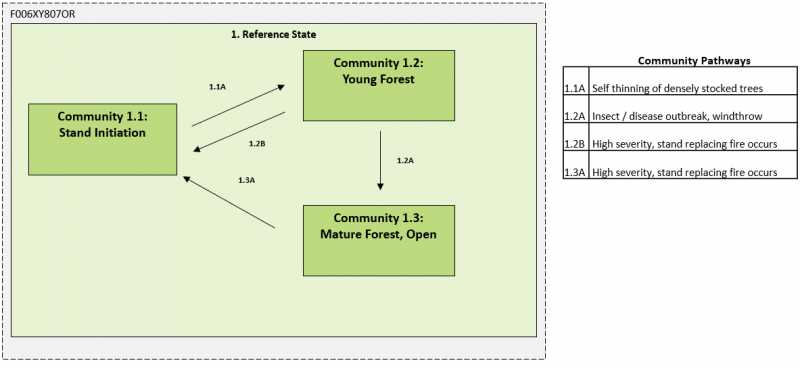
Natural Resources
Conservation Service
Ecological site F006XE807OR
Cryic Aquic Pumice Basins (PICO/SPDO-VAUL)
Last updated: 2/14/2025
Accessed: 12/21/2025
General information
Provisional. A provisional ecological site description has undergone quality control and quality assurance review. It contains a working state and transition model and enough information to identify the ecological site.
MLRA notes
Major Land Resource Area (MLRA): 006X–Cascade Mountains, Eastern Slope
Stretching from northern Washington to southern Oregon, the Cascade Mountains, Eastern Slope, spans the entirety of the mountain slopes, foothills, elevated plateaus and valleys on the eastern slopes of the Cascade mountains. This MLRA is a transitional area between the Cascade Mountains to the west and the lower lying Columbia Basalt Plateau to the east.
Situated in the rain shadow of the Cascade Crest, this MLRA receives less precipitation than portions of the cascades further west and greater precipitation than the basalt plateaus to the east. Geologically, the majority of the MLRA is dominated by Miocene volcanic rocks while the northern portion is dominated by Pre-Cretaceous metamorphic rocks and the southern portion is blanketed with a thick mantle of ash and pumice from Mount Mazama. The soils in the MLRA dominantly have a mesic, frigid, or cryic soil temperature regime, a xeric soil moisture regime, and mixed or glassy mineralogy. They generally are moderately deep to very deep, well drained, and loamy or ashy. Biologically, the MLRA is dominated by coniferous forest, large expanses of which are dominated by ponderosa pine, Douglas-fir or lodgepole pine. Areas experiencing cooler and moister conditions include grand fir, white fir, and western larch while the highest elevations include pacific silver fir, subalpine fir and whitebark pine.
Economically, timber harvest and recreation are important land uses in these forests. Historically, many of these forests would have experienced relatively frequent, low and mixed severity fire favoring the development of mature forests dominated by ponderosa pine or Douglas-fir. In the southern pumice plateau forests, less frequent, higher severity fire was common and promoted the growth of large expanses of lodgepole pine forests.
LRU notes
This unit is characterized by cold wet basins within the larger pumice plateau. Soils are mantled with geologically recent pumice and ash deposited by the eruptions of Mount Mazama and Newberry Caldera. Distinct from the greater pumice plateau, these basins promote the occurrence of water tables within 60 inches of the soil surface and saturated conditions for at least part of the year.
Broad scale cold air pooling interacts with this condition to facilitate the dominance of lodgepole pine forests and large marsh complexes. Botanical diversity is higher than in most sites within the larger pumice plateau, with marsh systems providing essential habitat for migratory waterfowl.
Forest communities in this unit are shaped by occasional stand replacing fires, promoting young stands of mostly pure lodgepole pine on many sites. The climate of this unit is cold and wet with a soil climate defined by a cryic temperature regime and an aquic moisture regime.
Classification relationships
Forested Plant Associations of the Oregon East Cascades (Simpson 2007)
CLM313 – Pinus contorta/Spiraea douglasii
CLM314 – Pinus contorta/Spiraea douglasii/Carex eurycarpa
PICO riparian plant association group
Plant Associations of the Central Oregon Pumice Zone (Volland 1985)
CLM111- PICO/SEDGE-GRASS - WETLAND
CLM211- PICO/BEARBERRY
CLM 311- PICO/BLUEBERRY/FORB – WETLAND
CLM312- Pinus contorta/Vaccinium uliginosum/Carex angustata
Landfire Biophysical Setting (Landfire 2007)
0711670 - Rocky Mountain Poor-Site Lodgepole Pine Forest
Ecological site concept
This site represents a broad group of lodgepole pine (Pinus contorta) dominated forest communities receiving subsurface moisture. Supplemental moisture from streams and other adjacent riparian areas allows the long-term competitive dominance of lodgepole pine over other conifer species as well as a diverse understory composed of a host of wet adapted shrubs and herbaceous species. This broadly defined site encompasses reference vegetative communities that include both obligate and facultative wetland plants yet experience similar ecological dynamics. Common members include Douglas spiraea (Spiraea douglasii), bog blueberry (Vaccinium uliginosum), willows (Salix spp.), wax currant (Ribes cereum), widefruit sedge (Carex angustata), Baltic rush (juncus arcticus) and blue wildrye (Elymus glaucus). This site may be distinguished from nearby forest communities by its aquic soil moisture regime, commonly characterized by a water table within 48 inches of the soil surface and occasional ponding or flooding.
This is a provisional ecological site that groups characteristics at a broad scale with little to no field verification and is subject to extensive review and revision before final approval. All data herein was developed using existing information and literature and should be considered provisional and contingent upon field validation prior to use in conservation planning.
Associated sites
| R006XB102OR |
Cold Wet Meadow Occupying locations closer to water bodies with higher water tables |
|---|
Similar sites
| R006XB102OR |
Cold Wet Meadow Water table closer to surface, meadows dominated by willows with few lodgepole |
|---|
Table 1. Dominant plant species
| Tree |
(1) Pinus contorta |
|---|---|
| Shrub |
(1) Spiraea douglasii |
| Herbaceous |
Not specified |
Click on box and path labels to scroll to the respective text.
Ecosystem states
State 1 submodel, plant communities
| 1.1A | - | Self thinning of densely stocked trees |
|---|---|---|
| 1.2B | - | High severity, stand replacing fire occurs |
| 1.2A | - | Extended time with periodic disturbance such as insect and disease outbreaks and windthrow |
| 1.3A | - | High severity, stand replacing fire occurs |
